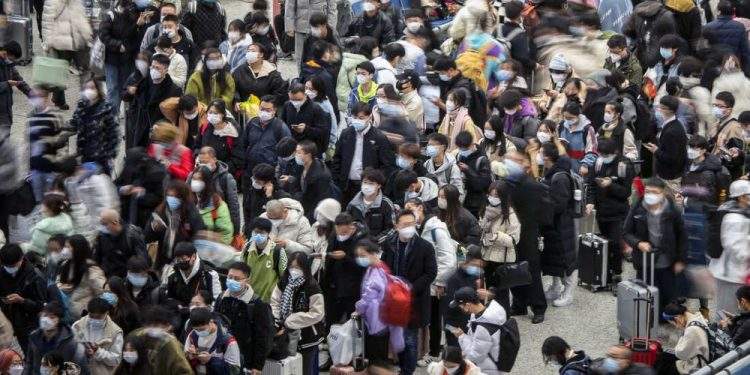Editor’s Note: I am posting this story by Shawn Jiang and Lynn Xu from our premium news partners at The Epoch Times because I’ll be discussing it on an upcoming episode of The JD Rucker Show. I contend that while the information in this story is accurate, the underlying narrative is far more deceptive. The Chinese Communist Party is using this new surge to drive an agenda that is almost certainly tied to the resurgences of the Pandemic Treaty for their puppets at the World Health Organization. Keep that in mind as you read the article.
China is facing a COVID crisis that Chinese experts predict will come to three peak waves that will last three to four months, with foreign experts warning that the tsunami-like epidemic will pose a serious challenge to the country’s health care system and could kill millions of people.
Outbreak May Last Four Months
Community doctors will undergo the largest wave of viral infections in history, said Zhang Wenhong, chief of the infection department at Huashan Hospital of Fudan University on Dec. 18, stressing that in this round of the epidemic, patients will be concentrated in communities; while in the past, they were more often in the quarantine sites or designated hospitals.
Asked when the epidemic would subside, Zhang suggested that it will take two to four months.
On Dec. 17, Wu Zunyou, chief epidemiologist of the Chinese Center for Disease Control and Prevention, spoke at an annual financial meeting that this winter’s epidemic can be summarized as “one peak and three waves.” The first wave will be from mid-December 2022 to mid-January 2023, mainly in cities and on the rise. The second wave will be from late January to mid-February 2023 when people flow before Chinese New Year. The third wave will be from late February to mid-March when people return to work after the New Year. These three waves constitute the peaks of the new winter epidemic, which will last about three months, according to Chinese portal site NetEase.
Wu predicted that the infection rate would be about 10 percent to 30 percent and the death rate would be about 0.09 percent to 0.16 percent, sounding the alarm to high-risk groups such as the vulnerable, elders, and people with underlying diseases.
Caution should be exercised to prevent tsunami-like outbreaks, Wu warned.
On Dec. 7, the Chinese regime suddenly lifted its “zero-COVID” policy that had been in place for three years. Since then, infections have soared, hospitals have been overwhelmed with patients, fever medicine sold out, funeral homes overloaded, and people in panic.
‘It Will Be a Tsunami’
Many epidemiological models suggest that the current outbreak in China will be huge. “Many of the models, the mathematical and epidemiology models [show] that it will be a tsunami,” said Jennifer Bouey, director of China policy research at RAND, an American think tank, at an online discussion hosted by the agency on Dec. 15.
It is expected to last for several months, depending on the state of China’s health care system, he said.
Bouey believes the upper limit of the Chinese health system will be reached soon, and models suggest it may be within 30 to 40 days, at the end of January, which coincides with the Chinese New Year. “We will see probably the first crisis relates to the health system. But I think the infection will have multiple waves in the next six months,” Bouey said.
Bouey pointed out that the biggest problem is the Chinese regime’s lack of preparation this summer, with lower booster vaccination rates, antiviral drugs, and ICU beds, “I feel that there’s almost no preparation before this.” He said.
Death Toll May Exceed 1 Million
Models prediction published in The Economist on Dec. 15 predict that 1.5 million Chinese could die if the virus were allowed to run its course. In the worst-case scenario, about 96 percent of the population will contract the virus in the next three months and demand for ICU beds will rapidly outpace supply, with people over the age of 60 accounting for 90 percent of deaths. At its peak, nearly 2 percent of the working-age population will be infected with symptoms.
A research report released on Dec. 14, co-written by Gabriel Leung, former dean of the Faculty of Medicine of the University of Hong Kong, said that without large-scale measures such as enhanced vaccination, the deaths toll in China could reach 684 per million people after the lifting of the restrictions, bringing the total number of deaths to 960,000 for China’s population of 1.4 billion, according to Bloomberg.
‘Could Have Been Avoided’
Larry Gostin, a professor at Georgetown University School of Law and director of the World Health Organization’s Coordinating Centre for Public Health Law and Human Rights, told VOA on Dec. 7 that he was surprised to see such a confusing withdrawal from the zero-COVID policy in China, with no clear plan to cope with an overburdened health system.
He said that the three-year zero-COVID policy has resulted in very low natural immunity among the public and inadequate booster vaccination rates in the Chinese population. These factors, combined with the highly transmissible Omicron variant, could lead to a spike in hospitalizations and deaths in China, especially among the elderly and those with chronic diseases.





